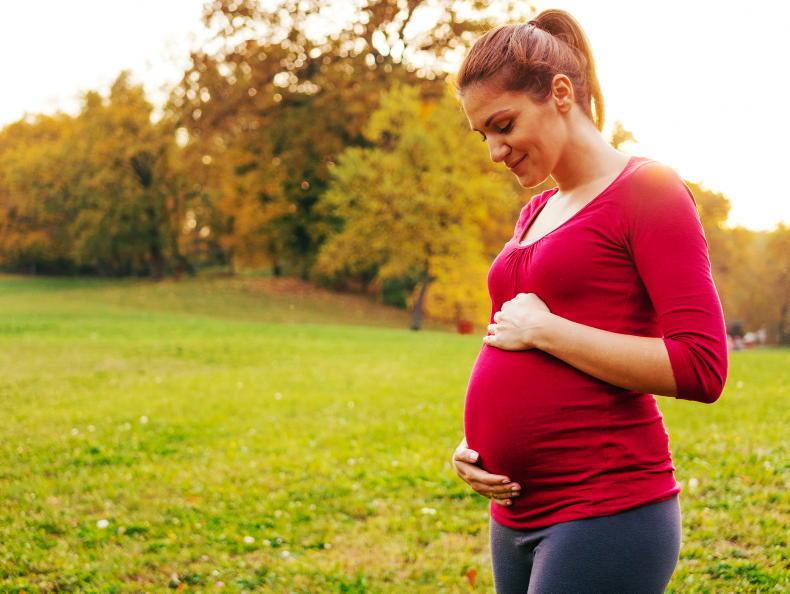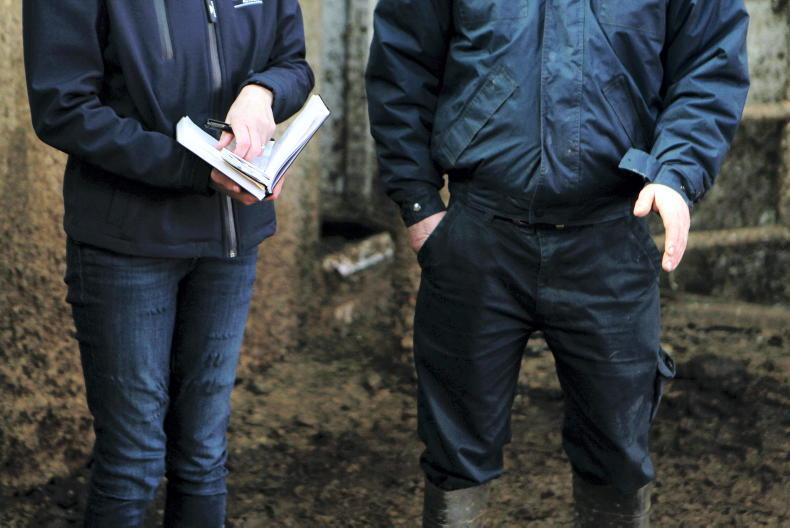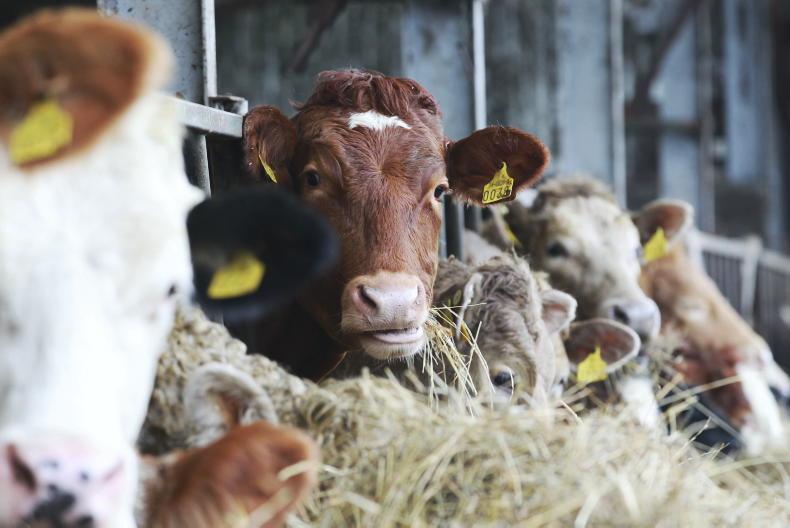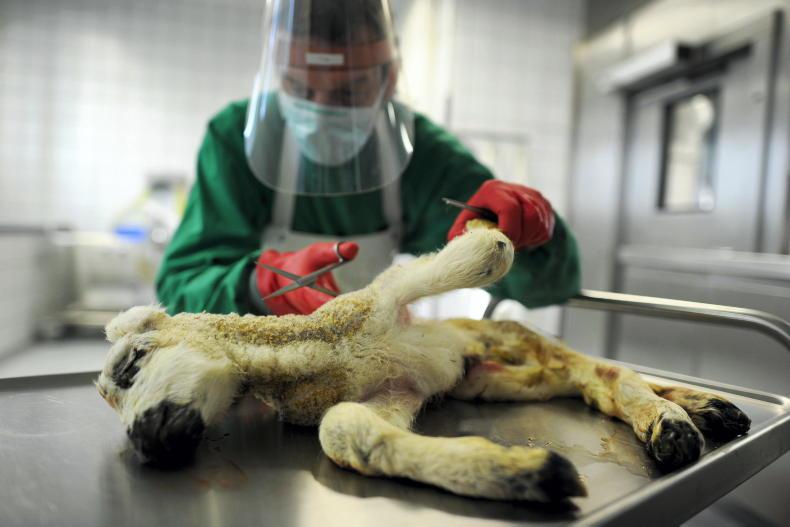Deciding to have a child when you’re a self-employed farmer has many implications. With the farmyard being a busy and often dangerous place, what should you be thinking about as you plan your pregnancy?
Kate O’Dwyer is a veterinary surgeon (large animal practice) in Templemore, Co Tipperary. She is the mother of two boys – a five-year-old and a three-year-old. She is self-employed and worked through both pregnancies. She tells us about the risks she had to bear in mind every day.

Kate O’Dwyer is a veterinary surgeon (large animal practice) in Templemore, Co Tipperary.
“Just be careful,” she says. “Remember all the basic things like wearing gloves. That’s how I survived, I became careful. When you’re self-employed you feel like the whole world is depending on you, that you need to do everything because there is nobody else, but help is vital. Make sure there is someone there to take up the mantle.”
While Kate found that she was able to do the same amount of work for the first four or five months as she wasn’t limited by a “bump”, she was very aware of zoonoses (diseases that can transfer from animals to humans) from the start.
“I had to be more careful going out to calve a cow or lamb a ewe to make sure to double glove and when I was degloving to make sure I didn’t get anything on myself,” she says.
“There are lots of zoonoses that aren’t talked about so much, like E coli, salmonella and campylobacter. They are all in the environment all of the time but toxoplasma* stands out because it actually affects the unborn baby whereas if you got salmonella or E coli you get sick.
“As a pregnant person you shouldn’t be getting sick. You could get severe gastroenteritis, which leads to severe complications. You have to be extra careful when you are pregnant because you are more vulnerable. It means extra PPE. I was always, always double gloved.”
Injections
She advises great care around pregnant farmers administering animal injections also.
“There are some used on farms like hormone injections and corticosteroids that require very, very careful handling, especially if you’re pregnant. Use the blue gloves and dispose of them carefully when finished. If putting a spot-on on cattle’s backs for example, always wear gloves too. When pregnant, I would say wear them all the time when dosing/treating animals or get someone else to do these jobs.”
Never handle animals on your own
She emphasises the importance of getting help when handling animals too.
“Never handle animals on your own. When you’re pregnant you’re slower to get back up if you fall. You might not be able to get back up so always have someone there with you. Sometimes we take silly risks but you don’t get a second chance when you are pregnant. You just cannot move fast enough. I’m not one to say that we are incapacitated when we’re pregnant but we do move slower.”
Be more aware of escape routes
She has found that, when pregnant, she was always more aware of escape routes when working with cattle.
“I would always be more aware of the gap, how far away I was and how wide it was and how quickly I would get to it and if I had to climb it would I be able to climb it. Always have someone there with you – and to keep you in check if you are doing something silly.”
Before she becomes pregnant, the farmer should make any necessary improvements to her animal handling facilities.
“Make it all as handy as possible,” Kate says, “make sure that gates are hanging properly, that you don’t have to lift the gate to open it. It makes a huge difference.”
Ask for help
She also believes that organising help and asking for it is important.
“Don’t be afraid to ask for help,” she says. “Sometimes when you are a woman in a man’s world you’re afraid that you’ll be seen as ‘lesser’ if you ask for help when actually men like that you ask for help. That’s what I’ve learned. If unsure or in doubt about something you have to do, ask for help.
“After all who are you proving yourself to? Yourself or the men? I think any women who are farming have proven themselves already before they even start.”
Chemical care
“Avoidance would be my strong advice when it comes to chemicals. Even some of the chemicals used in sheep foot bathing can be quite toxic so get someone else to do those jobs.”
Kate also cautions about assuming that your pregnancy will be straightforward.
“I have seen women put on bed rest for months, which wouldn’t have been in their plan! It’s something to think about – that you might not be able to work up to month eight or nine.”
While 12 weeks’ maternity leave is the ideal, Kate’s experience is that getting two weeks off from farming would be the norm for female farmers after birth.
“There is no point in saying that there will be six months maternity leave. It doesn’t exist for self-employed people.”
Your own health and safety manager
Aoife Clarke – a chartered women’s health physiotherapist in the Rotunda hospital and a farmer’s daughter – points out that, when you are a farmer and pregnant, you have to be your own health and safety manager.
“It’s not as easy as when you’re employed where you get your set maternity leave,” she says.
“There can be pressure to get back to work early too when you’re self-employed, but it is important that you take your time and look after yourself during and after your pregnancy.”
Farmers tend to push themselves and push their bodies a lot, she believes.
“It’s important that during pregnancy that you not push through pain as this will make symptoms worse. You must manage your day, take more breaks, know when to stop and know when to seek help. You should be looking at your support network too, and organising help in advance.”
Pelvic girdle pain
Farming, by its nature, can involve a lot of physical work and this can aggravate what’s called pelvic girdle pain. This can include hip, lower back, pain down legs or around the bum or pubic bone areas.
“About one in four women during pregnancy will have pelvic girdle pain or back pain,” she says.
If any pregnant farmer experiences such pain, she advises getting a physiotherapy assessment at her first hospital visit.
“This is free as part of public health care. Whatever hospital you are going to, get in touch with the physiotherapy department early on. The key message is if you’ve any pain symptoms, stop what you’re doing. Getting advice early is important so that you will get into good practices from the start.”
Lifting
When it comes to lifting objects (or pushing and pulling objects) on a farm, you have to know your limitations and adhere to safe manual handling practices. Here is her general advice:
Know when something is too heavy (see warning signs below).Make sure you are bending from your knees.Keep your back straight.Use your leg and glute (butt) muscles to lift.Bring whatever you are carrying or lifting close to your body. Avoid twisting when lifting.
Warning signs when lifting
Warning signs that something is too heavy to lift are:
Having to hold your breath to lift it.Feeling strain at your pelvic floor muscles. Leaking (from bladder or bowel).Experience heaviness or a dragging sensation in pelvic area .Any pain.More prone to falls
Aoife also points out that those who are pregnant are more prone to falls.
“That’s because your centre of gravity is affected during pregnancy. It changes so that will affect your balance. You should take extra care getting up and down off machinery and walking on rough ground. Good supportive footwear, good ankle support in particular, is important as ligaments become more elastic in pregnancy so you can be more prone to injury.”
Post-natal recovery
Aoife points out the importance of taking maternity leave.
“I know that’s not easy as a self-employed person,” she says, “but your postnatal recovery rest is the most important thing for your recovery. If you get back to work too early there is a risk especially of pelvic floor problems so it is important to have a plan in place for after you have your baby.”
Resting as much as possible for the first six weeks after the birth is advised.
“You should wait 12 weeks to restart any high impact activity. It’s about managing your expectations, knowing what to expect postnatally and allowing your body time to heal as well.”
Toxoplasmosis*
Pregnant women who come into close contact with sheep during lambing or other farm animals that are giving birth, may put themselves and their unborn child at risk of contracting an infectious disease sometimes carried by these pregnant farm animals. Some of these diseases can cause abortion in people or foetal abnormality.
Don’t help with lambing or calving.Avoid contact with newborn animals or with afterbirth, birthing fluids or bedding contaminated with such fluids.Avoid handling clothing, boots or any materials that may have come into contact with animals that have recently given birth, their young or afterbirths. Ensure contacts or partners attending animals giving birth take appropriate health and hygiene precautions ie wearing PPE and adequate washing.Useful links
HSA pregnancy at work leaflet. HSA pregnant at work FAQ.Visit BeSmart.ie for a risk assessment tool template for your farm.For pelvic floor exercises (pre- and post-natally) see the Rotunda YouTube channel (physiotherapy classes).
Deciding to have a child when you’re a self-employed farmer has many implications. With the farmyard being a busy and often dangerous place, what should you be thinking about as you plan your pregnancy?
Kate O’Dwyer is a veterinary surgeon (large animal practice) in Templemore, Co Tipperary. She is the mother of two boys – a five-year-old and a three-year-old. She is self-employed and worked through both pregnancies. She tells us about the risks she had to bear in mind every day.

Kate O’Dwyer is a veterinary surgeon (large animal practice) in Templemore, Co Tipperary.
“Just be careful,” she says. “Remember all the basic things like wearing gloves. That’s how I survived, I became careful. When you’re self-employed you feel like the whole world is depending on you, that you need to do everything because there is nobody else, but help is vital. Make sure there is someone there to take up the mantle.”
While Kate found that she was able to do the same amount of work for the first four or five months as she wasn’t limited by a “bump”, she was very aware of zoonoses (diseases that can transfer from animals to humans) from the start.
“I had to be more careful going out to calve a cow or lamb a ewe to make sure to double glove and when I was degloving to make sure I didn’t get anything on myself,” she says.
“There are lots of zoonoses that aren’t talked about so much, like E coli, salmonella and campylobacter. They are all in the environment all of the time but toxoplasma* stands out because it actually affects the unborn baby whereas if you got salmonella or E coli you get sick.
“As a pregnant person you shouldn’t be getting sick. You could get severe gastroenteritis, which leads to severe complications. You have to be extra careful when you are pregnant because you are more vulnerable. It means extra PPE. I was always, always double gloved.”
Injections
She advises great care around pregnant farmers administering animal injections also.
“There are some used on farms like hormone injections and corticosteroids that require very, very careful handling, especially if you’re pregnant. Use the blue gloves and dispose of them carefully when finished. If putting a spot-on on cattle’s backs for example, always wear gloves too. When pregnant, I would say wear them all the time when dosing/treating animals or get someone else to do these jobs.”
Never handle animals on your own
She emphasises the importance of getting help when handling animals too.
“Never handle animals on your own. When you’re pregnant you’re slower to get back up if you fall. You might not be able to get back up so always have someone there with you. Sometimes we take silly risks but you don’t get a second chance when you are pregnant. You just cannot move fast enough. I’m not one to say that we are incapacitated when we’re pregnant but we do move slower.”
Be more aware of escape routes
She has found that, when pregnant, she was always more aware of escape routes when working with cattle.
“I would always be more aware of the gap, how far away I was and how wide it was and how quickly I would get to it and if I had to climb it would I be able to climb it. Always have someone there with you – and to keep you in check if you are doing something silly.”
Before she becomes pregnant, the farmer should make any necessary improvements to her animal handling facilities.
“Make it all as handy as possible,” Kate says, “make sure that gates are hanging properly, that you don’t have to lift the gate to open it. It makes a huge difference.”
Ask for help
She also believes that organising help and asking for it is important.
“Don’t be afraid to ask for help,” she says. “Sometimes when you are a woman in a man’s world you’re afraid that you’ll be seen as ‘lesser’ if you ask for help when actually men like that you ask for help. That’s what I’ve learned. If unsure or in doubt about something you have to do, ask for help.
“After all who are you proving yourself to? Yourself or the men? I think any women who are farming have proven themselves already before they even start.”
Chemical care
“Avoidance would be my strong advice when it comes to chemicals. Even some of the chemicals used in sheep foot bathing can be quite toxic so get someone else to do those jobs.”
Kate also cautions about assuming that your pregnancy will be straightforward.
“I have seen women put on bed rest for months, which wouldn’t have been in their plan! It’s something to think about – that you might not be able to work up to month eight or nine.”
While 12 weeks’ maternity leave is the ideal, Kate’s experience is that getting two weeks off from farming would be the norm for female farmers after birth.
“There is no point in saying that there will be six months maternity leave. It doesn’t exist for self-employed people.”
Your own health and safety manager
Aoife Clarke – a chartered women’s health physiotherapist in the Rotunda hospital and a farmer’s daughter – points out that, when you are a farmer and pregnant, you have to be your own health and safety manager.
“It’s not as easy as when you’re employed where you get your set maternity leave,” she says.
“There can be pressure to get back to work early too when you’re self-employed, but it is important that you take your time and look after yourself during and after your pregnancy.”
Farmers tend to push themselves and push their bodies a lot, she believes.
“It’s important that during pregnancy that you not push through pain as this will make symptoms worse. You must manage your day, take more breaks, know when to stop and know when to seek help. You should be looking at your support network too, and organising help in advance.”
Pelvic girdle pain
Farming, by its nature, can involve a lot of physical work and this can aggravate what’s called pelvic girdle pain. This can include hip, lower back, pain down legs or around the bum or pubic bone areas.
“About one in four women during pregnancy will have pelvic girdle pain or back pain,” she says.
If any pregnant farmer experiences such pain, she advises getting a physiotherapy assessment at her first hospital visit.
“This is free as part of public health care. Whatever hospital you are going to, get in touch with the physiotherapy department early on. The key message is if you’ve any pain symptoms, stop what you’re doing. Getting advice early is important so that you will get into good practices from the start.”
Lifting
When it comes to lifting objects (or pushing and pulling objects) on a farm, you have to know your limitations and adhere to safe manual handling practices. Here is her general advice:
Know when something is too heavy (see warning signs below).Make sure you are bending from your knees.Keep your back straight.Use your leg and glute (butt) muscles to lift.Bring whatever you are carrying or lifting close to your body. Avoid twisting when lifting.
Warning signs when lifting
Warning signs that something is too heavy to lift are:
Having to hold your breath to lift it.Feeling strain at your pelvic floor muscles. Leaking (from bladder or bowel).Experience heaviness or a dragging sensation in pelvic area .Any pain.More prone to falls
Aoife also points out that those who are pregnant are more prone to falls.
“That’s because your centre of gravity is affected during pregnancy. It changes so that will affect your balance. You should take extra care getting up and down off machinery and walking on rough ground. Good supportive footwear, good ankle support in particular, is important as ligaments become more elastic in pregnancy so you can be more prone to injury.”
Post-natal recovery
Aoife points out the importance of taking maternity leave.
“I know that’s not easy as a self-employed person,” she says, “but your postnatal recovery rest is the most important thing for your recovery. If you get back to work too early there is a risk especially of pelvic floor problems so it is important to have a plan in place for after you have your baby.”
Resting as much as possible for the first six weeks after the birth is advised.
“You should wait 12 weeks to restart any high impact activity. It’s about managing your expectations, knowing what to expect postnatally and allowing your body time to heal as well.”
Toxoplasmosis*
Pregnant women who come into close contact with sheep during lambing or other farm animals that are giving birth, may put themselves and their unborn child at risk of contracting an infectious disease sometimes carried by these pregnant farm animals. Some of these diseases can cause abortion in people or foetal abnormality.
Don’t help with lambing or calving.Avoid contact with newborn animals or with afterbirth, birthing fluids or bedding contaminated with such fluids.Avoid handling clothing, boots or any materials that may have come into contact with animals that have recently given birth, their young or afterbirths. Ensure contacts or partners attending animals giving birth take appropriate health and hygiene precautions ie wearing PPE and adequate washing.Useful links
HSA pregnancy at work leaflet. HSA pregnant at work FAQ.Visit BeSmart.ie for a risk assessment tool template for your farm.For pelvic floor exercises (pre- and post-natally) see the Rotunda YouTube channel (physiotherapy classes). 









SHARING OPTIONS